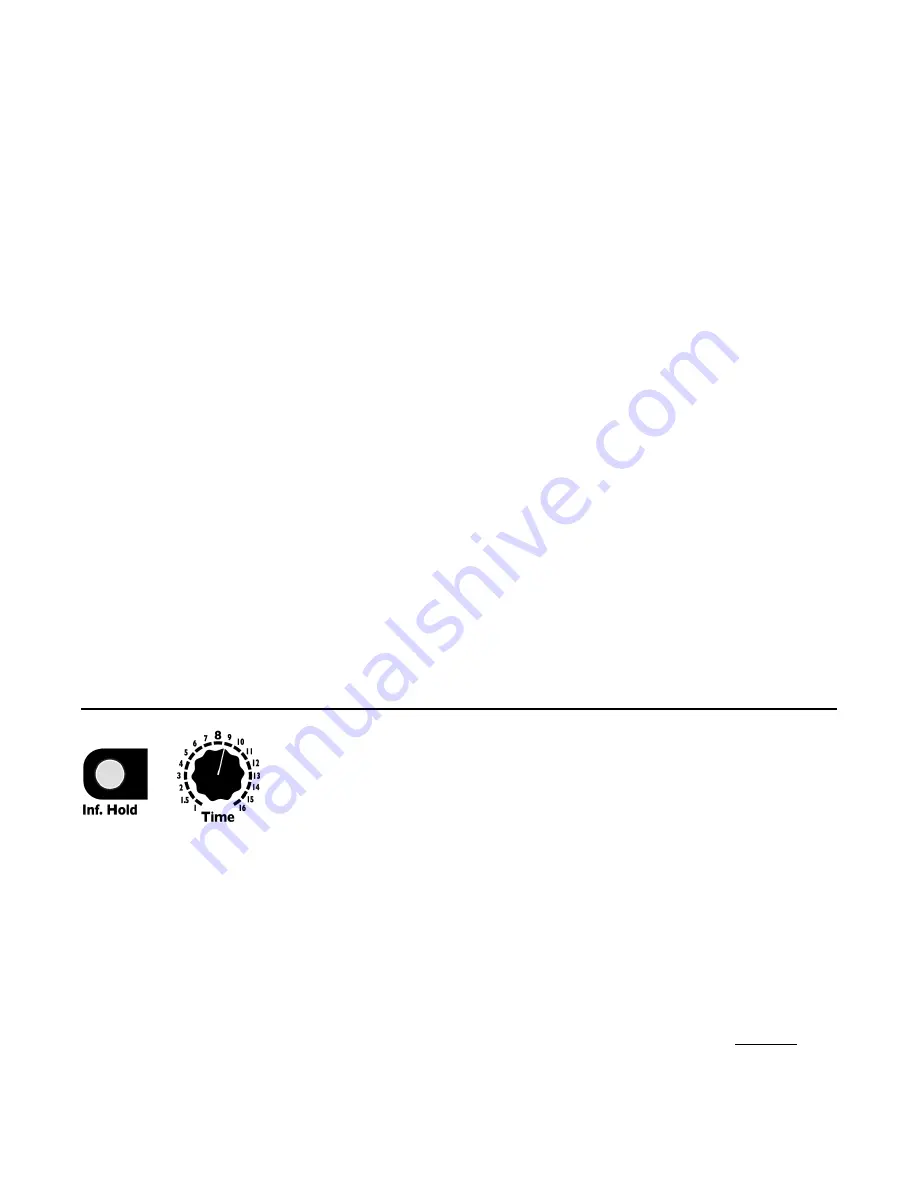
Listen to your loop, pay attention to what sounds the loop starts with, and what sounds it plays right
before it repeats. These are your loop start and stop points. Now, we're going to change those start and
stop points by Windowing:
1. Turn
Feedback
knob all the way up (the sound will not change).
2. Hold down
Inf. Hold
while you turn
Feedback
to 0%.
You just shifted the loop backwards by one whole loop length. Let it play for a bit as you listen to the
new start and stop points. Hear it? The loop is the same length (same timing/tempo), but now it will be
playing the sounds you recorded a few seconds earlier. Play with this some more: Press and hold
Inf.
Hold
again and turn
Feedback
back half a turn. Hear how the loop now starts in the middle?
Remember that turning
Feedback
while in
Inf. Hold
mode has no effect unless you're holding down
Inf. Hold
. This is critical for the next tip:
Tip #1:
If you want to scroll more than one loop length, do this maneuver:
1. Turn
Feedback
to 100%.
2. Depress the
Inf. Hold
button while you turn
Feedback
to 0%.
3. Release
Inf. Hold
button.
4. Repeat as needed (turn
Feedback
to 100%, then press button and turn
Feedback
back to 0,
release button...)
Tip #2:
If you want to scroll back very far even more quickly than Tip #1, change the
Time
parameter to
very long (perhaps flip the time switch up to +16). Since turning
Feedback
+
Inf. Hold
scrolls by
one
loop size
, making the loop size enormous lets you scroll by enormous amounts with just one knob twist!
You can scroll back a maximum of 87 seconds in mono mode, or 43 seconds in stereo mode.
Tip #3:
Set
Time
to a very short period and window around a loop with CV for a sort of granular effect.
Using CV With Windowing
The
Feedback
CV jack also allows you to window using external CV control. To enable the CV jack,
you must first manually hold down
Inf. Hold
and turn
Feedback
, even just a small amount. The
Feedback
CV jack will now control the window.
If you turn the
Feedback
knob at any time without holding down
Inf. Hold
, the
Feedback
CV jack will
no longer control the window.
Unquantized Time Mode and 1V/Oct CV
Normally the
Time
knob and CV are quantized to integer amounts (1-16),
and simple fractions (1 – 1/16). This is called
Quantized Time Mode
, and is
the default mode. It's possible to change to
Unquantized Time Mode
, where
the knob and CV provide continuous control of the
Time
parameter (not
quantized to integers or simple fractions)
To change to
Unquantized Time Mode,
turn the
Time
knob while holding
down the
Inf. Hold
button. To change back to
Quantized Mode
, turn the
Time
knob without holding down the
Inf. Hold
button.
In
Unquantized
mode, the
Time
knob behaves as usual, except it does not snap to the whole numbers
between 1 and 16. So you can sweep a slowly changing tempo, or set an exact tempo in between two
integer amounts. To adjust the
Time
knob in
Unquantized
mode, hold down the
Inf. Hold
button while
turning the
Time
knob.
The
Time
CV
jack behaves differently in
Unquantized
mode: It responds over a 1V/octave curve for
positive CV (5 octave range). Applying up to +5V will multiply the
Time
knob's setting in an exponential
curve relative to the voltage. That is, for every additional volt on the CV jack, the
Time
period will halve.
This response is opposite to
Quantized
mode, where additional voltage makes the period increase. The
1V/octave response in
Unquantized
mode is very useful for resonant delays.
Note that if the
Time
switch is up, the 1V/oct response will be altered by the addition of the extra 16
beats. For a more accurate 1V/oct response, keep the
Time
switch centered or down.
Page of
9
20
+




















